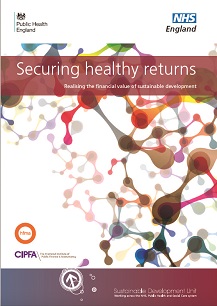Feature / Lightbulb moment
 The financial challenge facing the NHS, and the need to transform models of care,can seem all consuming. It is both immediate – NHS providers ended 2015/16 £2.45bn in deficit and this year looks equally tough – and likely to get worse in future years.
The financial challenge facing the NHS, and the need to transform models of care,can seem all consuming. It is both immediate – NHS providers ended 2015/16 £2.45bn in deficit and this year looks equally tough – and likely to get worse in future years.
Rising demand, driven by a rising and ageing population with greater levels of long-term conditions, means restricted growth funding must stretch even further.
This can push other goals into the sidelines – contributing to reducing the NHS carbon footprint, for example. But the two agendas are linked and a report in June highlighted opportunities to cut carbon emissions that would also ease NHS financial pressures.
‘The reality is that we only have limited resources – financially and environmentally – and we simply need to make the most of them,’ says Sandra Easton, chief financial officer of Chelsea and Westminster Hospital NHS Foundation Trust and chair of the new HFMA Environmental Sustainability Special Interest Group. ‘We increasingly have to see things in terms of a triple bottom line – planning and accounting in terms of the financial, environmental and social impact of service delivery – and understand the interconnectedness of these agendas.’
Ms Easton says the new HFMA group has been set up at an opportune moment, given the recent move towards whole health economy planning through the sustainability and transformation planning process. The group includes a representative from the Prince of Wales’ Accounting for Sustainability project, which aims to inspire finance leaders to adopt sustainable and resilient business models. It also involves accountancy body CIPFA and the Sustainable Development Unit.
An early task for the HFMA group was to survey finance managers about sustainability. It found that few people felt on top of the agenda. Many saw it as important but either struggled, or were reluctant, to take on responsibility. Some felt it was a distraction and there were more pressing issues to focus on.
The survey also identified a split in the NHS, with commissioners often seeing the agenda as more relevant to providers – the major users of energy and direct contributors to the service’s carbon footprint.
However, it unearthed an appetite to understand how to make progress. Helping to embed current good practice – as opposed to cutting edge activity – will be a major focus for the group. Ms Easton also wants organisations to move more towards private sector practice in reporting their performance in terms of their environmental and social impact as well as their finances. (Social sustainability is about taking decisions that help build and sustain healthy and liveable communities by supporting equity, diversity, quality of life and individual responsibility.)
In terms of good practice, Ms Easton says many organisations will have looked at the obvious quick wins in reducing carbon and energy costs – replacing lightbulbs with energy efficiency LED bulbs, for example. ‘But there are lots of other things you can do and that’s what we want to get some profile for – environmentally sustainable choices that support an organisation’s financial position.’
Just 35 such interventions – identified in a report from the Sustainable Development Unit, produced with the support of the HFMA sustainability group – could save an estimated £414m and cut one million tonnes of carbon emissions a year by 2020 by making changes that also benefit people’s health (see box). Measures range from reducing packaging on theatre kits in hospitals to replacing asthma inhalers with non-propellant versions.
‘It is about raising awareness of the easy-to-do things and making sure everyone is starting from a standard platform,’ says Ms Easton. ‘For example, ensuring we all have LED lights. The list of 35 things in the SDU report move us beyond this but are things we all could do. This is the standard we all should have.’
There are some who would argue that sustainability is an estates issue, that the only financial role should be approving an estates’ business plan – for example, replacing existing boilers or generators with combined heat and power plant. But Ms Easton insists that finance managers need to become more proactive in helping to lead and supporting the move towards greater sustainability.
Finance role
‘Yes, it must be led by the estates department – they will change the lightbulbs or put in the combined heat and power plant,’ she says. ‘But one barrier we’ve had is that people haven’t known how to translate an idea into a business case that a finance director understands. This is where finance needs to get involved.’
For some changes, Ms Easton says, the business case is straightforward – those lightbulbs again. Here’s the cost; here are the payback period and savings. ‘But for the things that are harder to quantify, and are more speculative in nature, estates may need help in making a solid business case,’ she adds.
Finance also needs to start challenging estates about what they are doing in certain areas. ‘Then they can work it up together and see if it flies,’ says Ms Easton. ‘Some things will be difficult to cash and to identify the benefit. They won’t be as easy as saying the electricity bill will be 10% cheaper. And as we think about pushing the boundaries on reducing our carbon footprint, we will need to have finance leading the charge so that we can get a detailed understanding of the benefits.’
It boils down to a joint responsibility for the finance and estates team, with the list of 35 interventions providing a handy checklist for initial discussions. ‘What do we already do and what could we do?’ says Ms Easton.
HFMA toolkit
The HFMA group is putting the list at the centre of its own work programme, she says. ‘We will take a handful of the 35 and develop a toolkit – this is what a business case would look like; these are the things you need to consider. We want to make it as easy as possible to help people move into a world where you consider the environmental impact as well as the financial.’
She says there is a good alignment with the recent Carter report on productivity, which also highlighted savings from energy consumption. However, the Carter report also suggested £700m could be saved from better procurement. In the past there has been tension between whether some financial savings on procurement could come at the expense of the environment, with cheaper prices offset by the higher carbon emissions released in greater transport distances where products are sourced from further away.
Ms Easton thinks better procurement can deliver on both fronts. ‘Greater use of hubs can be part of the solution – you don’t have 10 lorry journeys from a national depot travelling to 10 hospital sites; you have a lorry going to the hub and 10 smaller journeys from the hub.’
But she admits that the NHS needs to look beyond the simple financial impact in considering the sourcing of its supplies. ‘It will be a balance between lowest possible cost and buying locally,’ she says.
She accepts that, given the financial environment, the focus will be on interventions that deliver on both fronts – reducing carbon footprint and reducing costs. But there are also changes that can be made without incurring additional cost. ‘For example, one of the measures on the list of 35 is to prescribe non-propellant inhalers for asthma,’ she says. ‘That doesn’t cost the NHS anything but the carbon saving is the biggest on the list.’
This brings Ms Easton to a further misconception she wants to address – that reducing carbon emissions is a challenge for providers not for commissioners. Clearly, the non-propellant inhaler opportunity for appropriate cases demonstrates where commissioners can have a direct impact. But Ms Easton says that commissioners could do far more through the contracting process, moving beyond the lip service paid to the issue in the NHS standard contract. She suggests that the CQUIN mechanism would provide one way to incentivise interventions to improve the environmental impact. Commissioners may not have direct control of some of these issues, but they have levers that can be used. ‘Some of the barriers are actually just perceived rather than real barriers,’ she says.
‘We need to get sustainability firmly on board agendas,’ says Ms Easton. As well as providing practical tools to support this, the group hopes to show leadership and so encourage more finance directors to take a leading role in their own organisations.
Mapping out savings
Securing healthy returns estimates the health sector could save up to £414m a year and cut one million tonnes of carbon emissions every year by 2020 by making changes in 35 areas, many of which would have patient benefits too.
and cut one million tonnes of carbon emissions every year by 2020 by making changes in 35 areas, many of which would have patient benefits too.
The report, published in June by the Sustainable Development Unit on behalf of NHS England and Public Health England, was supported by the HFMA Environmental Sustainability Special Interest Group. It identifies a ‘clear proven financial case for sustainable development’ and a ‘critical role for healthcare finance professionals’.
It asserts that health bodies do not need to choose between saving financial resources or protecting the environment. ‘Indeed the most effective investments can often save money, improve health now and safeguard the environment on which all future health depends’.
The report focuses on 35 interventions that could deliver the savings, hoping this will support local investment decisions. But it says the list is not comprehensive. Prevention, waste (especially pharmaceuticals), new models of care and staff behaviour are identified as offering the most dramatic absolute savings financially and environmentally.
In the report’s foreword, NHS Improvement chair Ed Smith says finance professionals have a critical role to play ‘through supporting development of local leadership, governance arrangements and organisations’ plans and reporting’.
The report adds: ‘Finance professionals are crucial to realising and reporting savings from sustainable development management plans by ensuring they are valued and integrated into cost improvement programmes and given sufficient coverage in annual reports.’
It highlights eight ‘top opportunities’ for finance professionals. These include ensuring annual sustainability reports include financial savings and non-financial indicators, such as carbon reduction; staff mileage claims; use of finite natural resources; and social value indicators.
Finance staff should also look to ‘identify opportunities for sustainable development investment from outside the health sector through match funding, partnerships and collaboration’.
Related content
The Institute’s annual costing conference provides the NHS with the latest developments and guidance in NHS costing.
The value masterclass shares examples of organisations and systems that have pursued a value-driven approach and the results they have achieved.